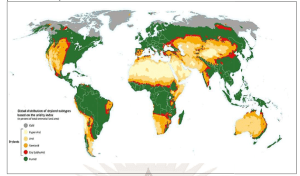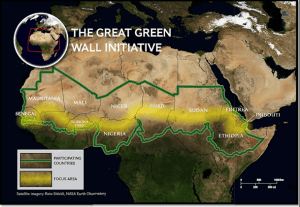APPROACH
Introduction: Define and briefly explain the concept of desertification.
THE BODY
-
- List various Factors influencing
- Explain how desertification is beyond Climate boundaries
- Give relevant examples and map.
Conclusion: Conclude with affirming the question statement and suggest importance of containing the desertification.
In 1994, the UN established the United Nations Convention to Combat Desertification (UNCCD) as the “sole legally binding international agreement linking environment and development to sustainable land management”. It states that desertification means “land degradation in arid, semi-arid and dry sub-humid areas resulting from various factors, including climatic variations and human activities”. Thus, the process of desertification goes beyond climate boundaries.
Climate Change
- Increased land surface temperature along with extreme events floods like droughts,
- Unusual rainfall patterns affecting vegetation cover
Soil Erosion
- Through natural forces: wind, rainwater, waves, etc OR human actions like over- grazing, deforestation, concretization
- Results in soil infertility and hence induces desertification
Human Settlements
- Ever increasing demand for converting fertile/vegetated land into concrete islands
- This along with human induced Climate Change pose irreversible damage in form of Desertification
Factors influencing Desertification
Desertification beyond Climate boundaries:

- Drylands are particularly susceptible to land degradation because of scarce and variable rainfall as well as poor soil Due to increased changes in Climate patterns, the outreach of such drylands is also accentuating.Thus, while the term ‘Desertification’ may bring to mind the windswept sand dunes of the Sahara or the vast salt pans of the Kalahari, it’s an issue that reaches far beyond those living in and around the world’s deserts, threatening the food security and livelihoods of billions.
- This can be seen through phenomenon like ‘Urban Heat Islands’/ ‘Urban deserts’ which can be seen with cities like New Delhi, Chennai. Even recently, Canada faced unprecedented rise in mercury levels which may hint at the start of desertification even in the Artic circle.
- The combined impact of climate change, land mismanagement and unsustainable freshwater use has seen the world’s water-scarce regions increasingly degraded. This leaves their soils less able to support crops, livestock and wildlife.
Effect of human actions:
According to The Hindu Kush Himalaya Assessment Report, even the most ambitious goal set by the Paris Agreement to limit global warming would lead to a 2.1 spike in temperature in the Hindu Kush Region,leading to melting of 1/3rd of the region’s glaciers by 2100, potentially destabilizing Asia’s rivers.
- Excessive exploitation of ground water for irrigation purpose in dryland areas is leading to further spread of desertification in those areas. E.g. in rain shadow areas of western ghats in Maharashtra,farmers growing sugar cane which is water thirsty crop.
- Due to over irrigation in certain areas, the soil is becoming alkaline/saline making it infertile. This contributes to further desertification. E.g. In Punjab and Haryana, farmers are growing agro-climatically not suitable crop of rice in these regions thereby making soil infertile.
Conclusion:
In this manner, it can be established that process of desertification does not have climate boundaries. Therefore, considering various SDG goals like life on land (goal 15), climate action (goal 13) among others the international communities must affirm resolute commitment to combat desertification with collective scrutiny and action.
The Great Green Wall Initiative
The Great Green Wall is a symbol of hope in the face of one of the biggest challenges of our time – desertification. Launched in 2007 by the African Union, this game-changing African-led initiative aims to restore Africa’s degraded landscapes and transform millions of lives in one of the world’s poorest regions, the Sahel. Once complete, the Wall will be the largest living structure on the planet – an 8,000 km natural wonder of the world stretching across the entire width of the continent.

The Great Green Wall is now being implemented in more than 20 countries across Africa and more than eight billion dollars hav been mobilized and pledged for its support. The initiative brings together African countries and international partners, under the leadership of the African Union Commission and Pan-African Agency of the Great Green Wall.
Spread the Word
